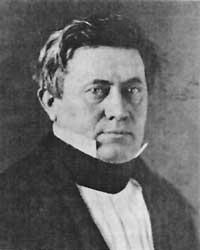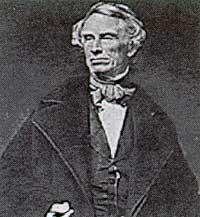Henry, Joseph
1995/08/02 Azkune Mendia, Iñaki - Elhuyar Fundazioa | Kaltzada, Pili - Elhuyar Zientziaren Komunikazioa
(1797-1878)
This American physicist was born in Albany in 1797. It was born in the bosom of a working family that only studied primary studies. Since he was young he had to work to survive and is said to dedicate his hours of play to learning. His curiosity seemed insatiable and he first took care of the natural phenomenon. He was a brilliant student who managed to be admitted to the Albany Academy, where he taught private classes to pay for classes. In 1826 he began teaching mathematics and sciences at the Albany Academy.

He did his most outstanding work in the field of electricity. I used the summer vacation to experience. Believing that science was a good of all society, it never patented inventions, which meant a great favor for scientists who were enriched based on Henry's works.
Henry became famous for his essays on electromagnets. I knew the coil system with iron core, but to increase the magnetic field it was necessary to increase its capacity. It accumulated many fine threads in a coil, but short circuits were produced. Until he discovered the electric insulator, it was impossible to create large magnetic fields. The news of what Henry did spread quickly, which allowed him to obtain the post of professor at the University of Princenton. Then he tried to create small electromagnets and together with Morse he created the first telegraph based on an electromagnet. More specifically, Henry first designed the telegraphic network, but Mors conducted the first practical experiments. That is why it is said that the telegraph's father is Morse.
It was not the telegraph the only invention that fled to Henry. In August 1830, taking advantage of his vacation, he discovered the principle of induction. The following year, with the aim of completing these studies, he returned to work without finishing. During the course Faraday was able to read the work done on induction. Henry did his first investigations, but Faraday published them.
Henry believed that when an electrical circuit conducts a current it generates a magnetic field. This makes the circuit itself immersed in this area. The electromagnetic induction that causes the variation of the current intensity in the circuit itself was called self-induction. Faraday came to that conclusion, but this time Henry was the first to publish it.
In 1846 he was appointed secretary of the Smithsonian Organization. There he worked a lot on the creation of communication channels between scientists. It contributed to the creation of the US Meteorology Institute, where the first scientific use of the telegraph occurred.
With the approval of the people, the US government and scientists, he died in Washington in 1878. In homage to the American physicist who in 1893 the International Electricity Congress approved the inscription of Henry to the self-induction unit.

Gai honi buruzko eduki gehiago
Elhuyarrek garatutako teknologia





